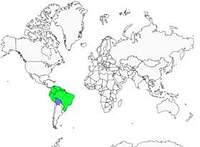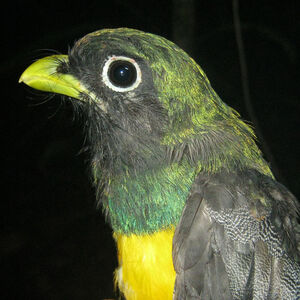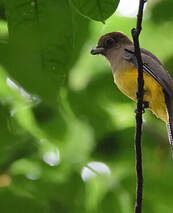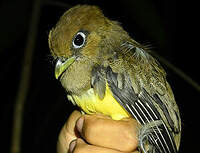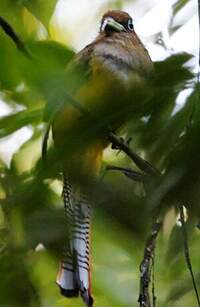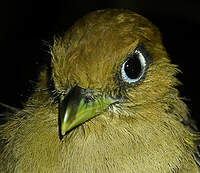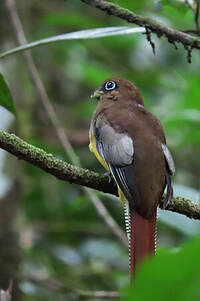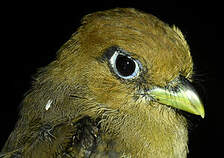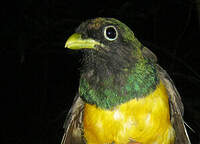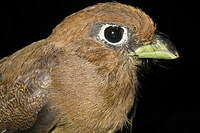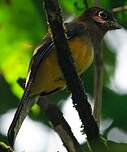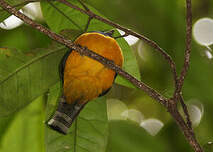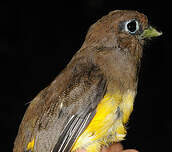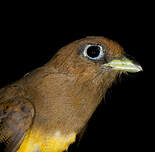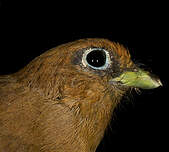Amazonian Black-throated Trogon
Trogon rufus - Trogon aurore
Identification
The Rufous Trogon is a charming trogon and is the origin of its name (rufus in Latin meaning red), as the female presents a magnificent red tail. The Anglo-Saxons call it the Black-throated Trogon or trogon with a black throat, the Spanish Trogon amarillo or yellow trogon, and our poetic French soul gave it the name of Trogon aurore. Its size, 23 to 25 cm, classifies it rather as one of the smaller trogons. The dimorphism is pronounced, the male presenting a powerful yellow beak surrounded by very visible black whiskers around both mandibles. The forehead and cap are emerald green, the throat and parotids black surround a dark brown almost black iris, highlighted by a very visible pale yellow orbital circle. The chest retains the beautiful emerald green colour of the forehead and cap and shapes a beautiful arc of circle at the limit of the golden yellow abdomen, a thin white mark separates the chest from the belly, the latter being more or less marked according to individuals and probably according to their age. The nape, mantle and back remain emerald green, tinged with turquoise blue nuances on the rump. The scapulars retain the green colouration, the coverings are of a very great finesse, presenting horizontal black and white vermiculation, the primary and secondary remiges are black, marked with a clear white line on the emarginations, the completely black primaries are worn long and curve over the bottom of the back and rump. The upper rectrices are olive green and barred with a clear black line at their tips, seen from the front they are horizontally striped with black and white, with three distinct white parts of which the part furthest from the end of the tail is very wide. The tip of the tail is underscored by the same black line visible on the upper rectrices.The female is very different, the beak is light yellow with a characteristic gray-black culmen, two white arcs at the front and back of the eye are visible, the crown, the nape and the whole back are dark brown. The chest is brown outlined with a wider white mark than the male, the white coloration darkening on both sides to become very light brown in the parts close to the covers. The belly is bright yellow. The green scapulars of the male are brown in the female, and the thin black and white vermiculations of the male's wing covers are transformed into delicate light brown and white waves, the upper rectrices are brown and end with the same horizontal black line, the lower rectrices maintaining the same marking as the male. The tarses, barely visible, are gray-blue in the male and gray in the female. The juveniles resemble their mother and are therefore mainly brown, the belly is not yet colored yellow and adopts a very pale light brown shade, young males have not yet the black and white vermiculations of the covers but have the same shade as their mothers brown and white. Six subspecies (ssp) are recognized: ssp rufus which gives its name to the species (from Venezuela to Guyana, Bolivia and the center of Brazil); ssp sulphureus with copper-colored upper rectrices, green and black at the tip of the tail, the green of the back not tinted blue on the croup, the orbital circle yellow, the coarse brown and white vermiculations of the female (east of the Andes, Amazon, north of Mato Grosso); ssp amazonicus similar to sulphureus but with golden bronze upper rectrices (rather in the western part of the Amazon upstream of the Rio Negro, very difficult to distinguish from sulphureus ); ssp chrysochloros with finely marked wing covers more black than white in the male, the female will have the same characteristic on these covers which will present brown and dark waves, upper rectrices with a darker green color than rufus, lower rectrices with finer white stripes giving a darker tail (eastern Brazil, in the region of Bahia and Rio Grande do Sul, Mato Grosso do Sul); ssp cupreicauda like sulphureus but with green-bronze upper rectrices, coarse black and white vermiculations, white band between the chest and the belly very diffuse, or even absent, the belly is more yellow-orange than bright yellow, black and white stripes wider on the lower rectrices, the female transforms the brown color into brown-brown shade, very vague or absent pectoral white mark, the color of the yellow belly is yellow-ochre (northwest Ecuador, northern Colombia); ssp tenellus neck and back more golden green, lower back and croup blue-turquoise, dark blue-turquoise upper rectrices, lower rectrices with three very wide white marks, the white pectoral band is always present, pale blue orbital circle, the female has the lower chest and the belly pale yellow (Central America and northern Colombia).
Subspecific information 3 subspecies
- Trogon rufus rufus (e Venezuela, the Guianas and n Brazil)
- Trogon rufus sulphureus (se Colombia, e Ecuador, ne Peru and w Brazil)
- Trogon rufus amazonicus (ne Brazil)
Foreign names
- Trogon aurore,
- Trogón amarillo,
- surucuá-dourado,
- Schwarzkehltrogon,
- feketetorkú aranytrogon,
- Zwartkeeltrogon,
- Trogone golanera,
- svartstrupig trogon,
- Edeltrogon,
- trogón čiernohrdlý,
- trogon černohrdlý,
- Sortstrubet Trogon,
- viheltäjätrogoni,
- trogon maragda,
- trogon rdzawy,
- Черногорлый трогон,
- ミドリキヌバネドリ,
- 黑喉美洲咬鹃,
- svartstrupig trogon,
- 黑喉美洲咬鵑,
Voice song and call
Habitat
The Black-throated Trogon prefers dense and humid primary forests, rarely over high altitudes, maximum up to 1400 meter in Central America.
Behaviour character trait
Exclusively sedentary. Black-throated Trogon (Trogon aurore)
Dietfeeding habits
If the Black-throated Trogon loves fruits, particularly figs or berries (it seems to have a preference for fruits from the Didimoponax morototoni plant), it appears to be mostly insectivorous.
American ornithologist Alexander Wetmore (1886-1978) observed in 1968 in Costa Rica the Black-throated Trogon with other birds near swarms of ants. Other observations in the Corcovado National Park mention its presence near groups of Saimiri oerstedi (for Tintin fans: the capuchin monkey!) where the Black-throated Trogon waited for the monkeys to flush out various insects and larvae so it could capture them.Reproduction nesting
From February to June in Costa Rica and Panama, from February to May in Colombia, October in Guyana, and May in Brazil, Black-throated Trogons often build their nest in excavated old trees at the fork of large branches and trunks, and occasionally use old woodpecker nests.
Nests are usually low, from 1 to 6 meters high, with an entrance of 11 to 16 cm tall and 6 to 7 cm wide, and a tunnel up to the chamber usually of 5 cm. The clutch is usually two eggs deposited often one day apart on a bed of bark debris gathered during the construction of the nest. Incubation lasts 18 days and both parents incubate, the female at night and the male during the day. They both feed their chicks in alternating turns, who leave the nest at 14 to 15 days. Sexual maturity seems to arrive at a minimum at 2 years old.Geographic range
According to the distribution of the 6 subspecies, the Black-throated Trogon can be found in Central America from Honduras to Panama, and then in the north of the Andes Mountains, Colombia, Ecuador and Venezuela. Its range extends throughout the Amazon, Peru and Brazil to Suriname and Guyana.
Threats - protection
IUCN conservation status
concern
in the Wild
threatened
evaluated
The Black-throated Trogon doesn't seem to be in danger, since its preference for difficult to access primary forest helps it to remain safe. However, deforestation will likely become its greatest enemy in the near future. The ssp chrysochloros, which is separate from other ssp in the south of Brazil, is becoming increasingly difficult to find outside of certain national parks, which is a sign of our inability to look up and preserve and admire this beautiful trogon.
Sources of information
- IOC World Bird List (v14.2), Gill, F and D Donsker (Eds). 2024-04-18.
- Vol. 6 - Handbook of the Birds of the World, Josep del Hoyo-Andrew Elliott-Jordi Sargatal
- The Birds of Panama, George R.Anger Robert Dean
- xeno-canto, Sharing bird sounds from around the world,
- Avibase, Lepage Denis
- Neotropical Birds Online,
- Planet of Birds,
- Wikipédia, Wikipedia, The Free Encyclopedia
- A Natural history of the Trogonidae, Joseph M.Forshaw Albert Earl Gilbert
Other sources of interest
 Specification sheet created on
31/07/2023 by Anne et Gabriel Leboff
Specification sheet created on
31/07/2023 by Anne et Gabriel LeboffTranslation by AI Oiseaux.net
© 1996-2025 Oiseaux.net
- Accipitriformes
- Aegotheliformes
- Anseriformes
- Apodiformes
- Apterygiformes
- Bucerotiformes
- Caprimulgiformes
- Cariamiformes
- Casuariiformes
- Charadriiformes
- Ciconiiformes
- Coliiformes
- Columbiformes
- Coraciiformes
- Cuculiformes
- Eurypygiformes
- Falconiformes
- Galliformes
- Gaviiformes
- Gruiformes
- Leptosomiformes
- Mesitornithiformes
- Musophagiformes
- Nyctibiiformes
- Opisthocomiformes
- Otidiformes
- Passeriformes
- Pelecaniformes
- Phaethontiformes
- Phoenicopteriformes
- Piciformes
- Podargiformes
- Podicipediformes
- Procellariiformes
- Psittaciformes
- Pterocliformes
- Rheiformes
- Sphenisciformes
- Steatornithiformes
- Strigiformes
- Struthioniformes
- Suliformes
- Tinamiformes
- Trogoniformes


